Dual-Mode Microfluidic Workstation for Rapid Detection of Multiple Mycotoxins on Chip
Abstract
1. Introduction
2. Materials and Methods
2.1. Materials and Instruments
2.2. Design of Microfluidic Chip
2.3. Fabrication of Microfluidic Chip
2.4. Lab on Microfluidic Chip
2.5. Incubation of Antigens on Reaction Layer
2.6. Statistical Evaluation
3. Results and Discussion
3.1. The Construction of Microfluidic Chip
3.2. The Mixing Performance of Micromixer
3.3. The Microfluidic Chip for the Detection
3.4. The Establishment of DMMW
3.5. Detection Performance
4. Conclusions
Author Contributions
Funding
Data Availability Statement
Conflicts of Interest
Abbreviations
| DMMW | Dual-Mode microfluidic Workstation |
| SA-Biotin-ALP | Streptavidin-biotin-alkaline phosphatase |
| DON | Deoxynivalenol |
| OTA | Ochratoxin A |
| AFB1 | Aflatoxin B1 |
| ic-ELISA | Indirect competitive enzyme-linked immunoassay |
| LOD | limit of detection |
| CL | Chemiluminescent |
| HPLC | High-performance liquid chromatography |
| LC-MS | Liquid chromatography–mass spectrometry |
| POCT | Point of care testing |
| PDMS | Polydimethylsiloxane |
| OVA | Ovalbumin |
| IgG-Biotin | Detection antibody conjugated with Biotin |
| SA | Streptavidin |
| PNPP | 4-nitrophenyl phosphate |
| Biotin-ALP | Alkaline phosphatase conjugated with Biotin |
| BSA | Bovine Serum Albumin |
| APS-5 | Disodium [(4-chlorophenyl) sulfanyl] (10-methyl-9(10H)-acridinylidene) methyl phosphate |
| Ab | Antibody |
| RSD | Relative standard deviation |
| CV | Coefficient of variation |
| Re | Reynolds numbers |
| CCD | Charge-coupled Device |
| OD | Optical density |
References
- Hou, Y.J.; Jia, B.Y.; Sheng, P.; Liao, X.F.; Shi, L.C.; Fang, L.; Zhou, L.D.; Kong, W.J. Aptasensors for mycotoxins in foods: Recent advances and future trends. Compr. Rev. Food Sci. Food Saf. 2022, 21, 2032–2073. [Google Scholar] [CrossRef] [PubMed]
- Bräse, S.; Encinas, A.; Keck, J.; Nising, C.F. Chemistry and Biology of Mycotoxins and Related Fungal Metabolites. Chem. Rev. 2009, 109, 3903–3990. [Google Scholar] [CrossRef] [PubMed]
- Anater, A.; Manyes, L.; Meca, G.; Ferrer, E.; Luciano, F.B.; Pimpao, C.T.; Font, G. Mycotoxins and their consequences in aquaculture: A review. Aquaculture 2016, 451, 1–10. [Google Scholar] [CrossRef]
- Hussein, H.S.; Brasel, J.M. Toxicity, metabolism, and impact of mycotoxins on humans and animals. Toxicology 2001, 167, 101–134. [Google Scholar] [CrossRef]
- Pitt, J.I.; Miller, J.D. A Concise History of Mycotoxin Research. J. Agric. Food Chem. 2017, 65, 7021–7033. [Google Scholar] [CrossRef]
- Yin, S.T.; Liu, X.Y.; Fan, L.H.; Hu, H.B. Mechanisms of cell death induction by food-borne mycotoxins. Crit. Rev. Food Sci. Nutr. 2018, 58, 1406–1417. [Google Scholar] [CrossRef]
- Awuchi, C.G.; Ondari, E.N.; Nwozo, S.; Odongo, G.A.; Eseoghene, I.J.; Twinomuhwezi, H.; Ogbonna, C.U.; Upadhyay, A.K.; Adeleye, A.O.; Okpala, C.O.R. Mycotoxins’ Toxicological Mechanisms Involving Humans, Livestock and Their Associated Health Concerns: A Review. Toxins 2022, 14, 167. [Google Scholar] [CrossRef]
- Wang, X.; Bouzembrak, Y.; Lansink, A.; Van der Fels-Klerx, H.J. Designing a monitoring program for aflatoxin B1 in feed products using machine learning. Npj Sci. Food 2022, 6, 40. [Google Scholar] [CrossRef]
- Pinotti, L.; Ottoboni, M.; Giromini, C.; Dell’Orto, V.; Cheli, F. Mycotoxin Contamination in the EU Feed Supply Chain: A Focus on Cereal Byproducts. Toxins 2016, 8, 45. [Google Scholar] [CrossRef]
- Eskola, M.; Kos, G.; Elliott, C.T.; Hajslová, J.; Mayar, S.; Krska, R. Worldwide contamination of food-crops with mycotoxins: Validity of the widely cited ‘FAO estimate’ of 25%. Crit. Rev. Food Sci. Nutr. 2020, 60, 2773–2789. [Google Scholar] [CrossRef]
- Zhou, W.; Wieczorek, M.N.; Pawliszyn, J. High throughput and automated solid-phase microextraction and determination by liquid chromatography-mass spectrometry for the analysis of mycotoxins in beer. Food Chem. 2023, 426, 136557. [Google Scholar] [CrossRef] [PubMed]
- Hickert, S.; Gerding, J.; Ncube, E.; Hübner, F.; Flett, B.; Cramer, B.; Humpf, H.U. A new approach using micro HPLC-MS/MS for multi-mycotoxin analysis in maize samples. Mycotoxin Res. 2015, 31, 109–115. [Google Scholar] [CrossRef] [PubMed]
- Wang, Y.L.; Chai, T.J.; Lu, G.Z.; Quan, C.S.; Duan, H.Y.; Yao, M.L.; Zucker, B.A.; Schlenker, G. Simultaneous detection of airborne Aflatoxin, Ochratoxin and Zearalenone in a poultry house by immunoaffinity clean-up and high-performance liquid chromatography. Environ. Res. 2008, 107, 139–144. [Google Scholar] [CrossRef]
- Zhu, W.R.; Li, L.B.; Zhou, Z.; Yang, X.D.; Hao, N.; Guo, Y.S.; Wang, K. A colorimetric biosensor for simultaneous ochratoxin A and aflatoxins B1 detection in agricultural products. Food Chem. 2020, 319, 126544. [Google Scholar] [CrossRef]
- Chen, Y.Q.; Chen, Q.; Han, M.M.; Zhou, J.Y.; Gong, L.; Niu, Y.M.; Zhang, Y.; He, L.D.; Zhang, L.Y. Development and optimization of a multiplex lateral flow immunoassay for the simultaneous determination of three mycotoxins in corn, rice and peanut. Food Chem. 2016, 213, 478–484. [Google Scholar] [CrossRef]
- Maragos, C.M.; Busman, M. Rapid and advanced tools for mycotoxin analysis: A review. Food Addit. Contam. Part A-Chem. 2010, 27, 688–700. [Google Scholar] [CrossRef]
- Wang, C.L.; Sha, T.; Lu, J.S.; Guan, Y.F.; Geng, X.H. A Miniaturized and Highly Sensitive “Windmill” Three-Channel Fluorescence Detector for Simultaneous Detection of Various Mycotoxins. Anal. Chem. 2024, 96, 10121–10126. [Google Scholar] [CrossRef]
- Adunphatcharaphon, S.; Kolawole, O.; Sooksimuang, T.; Panchan, W.; Wasuthep, W.; Petdum, A.; Pichayawaytin, G.; Jintamethasawat, R.; Doljirapisit, N.; Somboonkaew, A.; et al. A multiplex microarray lateral flow immunoassay device for simultaneous determination of five mycotoxins in rice. Npj Sci. Food 2024, 8, 116. [Google Scholar] [CrossRef]
- Yang, Q.; Xiong, J.H.; Duan, L.Y.; Chen, S.D.; Peng, Z.J.; Liao, X.N.; Ning, Z.Q.; Wang, D. Polydopamine@ZIFs with enhanced electrochemiluminescence quenching performance for mycotoxin detection. Food Chem. 2024, 439, 138058. [Google Scholar] [CrossRef]
- Zhang, Y.; Zhao, C.P.; Picchetti, P.; Zheng, K.Y.; Zhang, X.A.; Wu, Y.L.; Shen, Y.; De Cola, L.; Shi, J.Y.; Guo, Z.M.; et al. Quantitative SERS sensor for mycotoxins with extraction and identification function. Food Chem. 2024, 456, 140040. [Google Scholar] [CrossRef]
- Li, L.T.; Wang, M.J.; Dong, Y.Z.; Yu, D.Y.; Chen, Y.P. Micropore Resistance Counting Platform for Multiplexed and Ultrasensitive Detection of Mycotoxins and Biomarkers. ACS Nano 2025, 19, 920–932. [Google Scholar] [CrossRef] [PubMed]
- Yang, W.; Li, X.N.; Zhang, M.J.; Wang, Q.; Wang, Y.J.; Yu, S.S.; Dang, R.H.; Wang, X.R.; Yang, Z.; Fan, S.H.; et al. N/O co-doping porous biomass carbon constructed electrochemical sensor for universal and sensitive detection to mycotoxins. Food Chem. 2025, 475, 143397. [Google Scholar] [CrossRef] [PubMed]
- Shi, Y.K.; Lang, H.Y.; Ye, J.; Xuan, Z.H.; Ni, B.X.; Xie, Y.L.; Liu, H.M.; Wang, S.X. A programmable multichannel chemiluminescence immunoassay sensor for automatic quantification of the total amount of fumonisin B1, B2 and B3. Food Chem. 2025, 478, 143548. [Google Scholar] [CrossRef]
- Yin, B.F.; Zhu, H.Y.; Zeng, S.Y.; Sohan, A.; Wan, X.H.; Liu, J.; Zhang, P.; Lin, X.D. Chip-based automated equipment for dual-mode point-of-care testing foodborne pathogens. Biosens. Bioelectron. 2024, 257, 116338. [Google Scholar] [CrossRef]
- Zeng, S.Y.; Zhu, H.Y.; Sohan, A.; Liu, J.; Wan, X.H.; Lin, X.D.; Yin, B.F. A remote-controlled portable workstation for highly sensitive and real-time chemiluminescent detection of cadmium. Food Chem. 2024, 452, 139549. [Google Scholar] [CrossRef]
- Lin, X.D.; Wu, H.T.; Zeng, S.Y.; Peng, T.; Zhang, P.; Wan, X.H.; Lang, Y.H.; Zhang, B.; Jia, Y.W.; Shen, R.; et al. A self-designed device integrated with a Fermat spiral microfluidic chip for ratiometric and automated point-of-care testing of anthrax biomarker in real samples. Biosens. Bioelectron. 2023, 230, 115283. [Google Scholar] [CrossRef]
- Jiang, Z.A.; Zhuang, Y.; Guo, S.T.; Sohan, A.; Yin, B.F. Advances in Microfluidics Techniques for Rapid Detection of Pesticide Residues in Food. Foods 2023, 12, 2868. [Google Scholar] [CrossRef]
- El-Ali, J.; Sorger, P.K.; Jensen, K.F. Cells on chips. Nature 2006, 442, 403–411. [Google Scholar] [CrossRef]
- Yin, B.F.; Wan, X.H.; Qian, C.C.; Sohan, A.; Zhou, T.; Yue, W.K. Enzyme Method-Based Microfluidic Chip for the Rapid Detection of Copper Ions. Micromachines 2021, 12, 1380. [Google Scholar] [CrossRef]
- Soares, R.R.G.; Santos, D.R.; Pinto, I.F.; Azevedo, A.M.; Aires-Barros, M.R.; Chu, V.; Conde, J.P. Multiplexed microfluidic fluorescence immunoassay with photodiode array signal acquisition for sub-minute and point-of-need detection of mycotoxins. Lab. Chip 2018, 18, 1569–1580. [Google Scholar] [CrossRef]
- Soares, R.R.G.; Santos, D.R.; Chu, V.; Azevedo, A.M.; Aires-Barros, M.R.; Conde, J.P. A point-of-use microfluidic device with integrated photodetector array for immunoassay multiplexing: Detection of a panel of mycotoxins in multiple samples. Biosens. Bioelectron. 2017, 87, 823–831. [Google Scholar] [CrossRef] [PubMed]
- Chen, Y.Q.; Meng, X.R.; Zhu, Y.Z.; Shen, M.J.; Lu, Y.; Cheng, J.; Xu, Y.C. Rapid detection of four mycotoxins in corn using a microfluidics and microarray-based immunoassay system. Talanta 2018, 186, 299–305. [Google Scholar] [CrossRef] [PubMed]
- Lin, X.D.; Cao, Z.Y.; Zeng, S.Y.; Zhu, H.Y.; Zhai, K.R.; Yin, B.F.; Zhang, C.; Peng, T.; Cheng, T.; Zhang, B. Portable dual-mode microfluidic sensor for rapid and sensitive detection of DPA on chip. Adv. Compos. Hybrid Mater. 2025, 8, 240. [Google Scholar] [CrossRef]
- Xiang, X.R.; Song, M.H.; Xu, X.W.; Lu, J.R.; Chen, Y.Y.; Chen, S.H.; He, Y.L.; Shang, Y.T. Microfluidic Biosensor Integrated with Signal Transduction and Enhancement Mechanism for Ultrasensitive Noncompetitive Assay of Multiple Mycotoxins. Anal. Chem. 2023, 95, 7993–8001. [Google Scholar] [CrossRef]
- Hua, M.Z.; Liu, J.X.; Roopesh, M.S.; Lu, X.N. Microfluidic Optical Aptasensor for Small Molecules Based on Analyte-Tuned Growth of Gold Nanoseeds and Machine Learning-Enhanced Spectrum Analysis: Rapid Detection of Mycotoxins. ACS Sens. 2024, 9, 6299–6308. [Google Scholar] [CrossRef]
- Wang, X.R.; Xing, G.W.; Wu, Z.N.; Lin, H.F.; Lin, Y.N.; Lin, J.X.; Xie, Y.S.; Liao, W.J.; Lin, L. Microfluidic-engineered portable microsphere sensors for multi-mycotoxins detection. Chem. Eng. J. 2025, 506, 159834. [Google Scholar] [CrossRef]
- Wu, J.L.; Yuan, H.J.; Yang, Y.H.; Yang, P.; Yan, X.X.; Mu, Y.; Jin, Q.H.; Yang, P.H.; Gao, W.L. A comb-shaped microfluidic aptasensor for rapid and sensitive on-site simultaneous detection of aflatoxin B1 and deoxynivalenol. Food Chem. 2025, 473, 143072. [Google Scholar] [CrossRef]
- Zeng, S.Y.; Sun, X.C.; Wan, X.H.; Qian, C.C.; Yue, W.K.; Sohan, A.; Lin, X.D.; Yin, B.F. A cascade Fermat spiral microfluidic mixer chip for accurate detection and logic discrimination of cancer cells. Analyst 2022, 147, 3424–3433. [Google Scholar] [CrossRef]
- Liu, J.; Zeng, S.Y.; Zhu, H.Y.; Wan, X.H.; Sohan, A.; Yin, B.F. A Portable Automated Microfluidic Platform for Point-of-Care Testing for Multiple Mycotoxins in Wine. Foods 2024, 13, 2066. [Google Scholar] [CrossRef]
- Wu, J.; Chen, Y.P.; Yang, M.Z.; Wang, Y.; Zhang, C.; Yang, M.; Sun, J.S.; Xie, M.X.; Jiang, X.Y. Streptavidin-biotin-peroxidase nanocomplex-amplified microfluidics immunoassays for simultaneous detection of inflammatory biomarkers. Anal. Chim. Acta 2017, 982, 138–147. [Google Scholar] [CrossRef]
- Huang, Q.; Yang, H.J.; Wang, W.L.; Zhang, Y. Multi-target photothermal immunochromatography for simultaneous detection of three mycotoxins in foods. Anal. Chim. Acta 2023, 1279, 341784. [Google Scholar] [CrossRef] [PubMed]
- Lin, X.Q.; Ge, R.; Wei, J.; Jiao, T.H.; Chen, Q.M.; Oyama, M.; Chen, Q.S.; Chen, X.M. Magnetic-encoded fluorescent nanospheres-based competitive immunoassay for near-simultaneous detection of four mycotoxins in wheat. Food Chem. 2024, 432, 137267. [Google Scholar] [CrossRef] [PubMed]
- Shen, Y.H.; Chen, Y.Y.; Wang, H.F.; Zhao, X.L.; Lu, H.X.; Zhu, J.L. Immunochromatographic assay integrated smartphone-based device for simultaneous detection of multiple mycotoxins using core-shell up-conversion nanoparticles. Sens. Actuator B-Chem. 2024, 398, 134783. [Google Scholar] [CrossRef]
- Yin, L.M.; You, T.Y.; Arslan, M.; El-Seedi, H.R.; Guo, Z.M.; Zou, X.B.; Cai, J.R. Dual-layers Raman reporter-tagged Au@Ag combined with core-satellite assemblies for SERS detection of Zearalenone. Food Chem. 2023, 429, 136834. [Google Scholar] [CrossRef]
- Damphathik, C.; Prakobkij, A.; Jarujamrus, P.; Boonmak, J.; Suebphanpho, J.; Bunkoed, O.; Samphao, A. Colorimetric sensor comprising metal-organic frameworks and molecularly imprinted polymers for aflatoxin B1 detection in agricultural commodities. Food Chem. 2025, 474, 143105. [Google Scholar] [CrossRef]
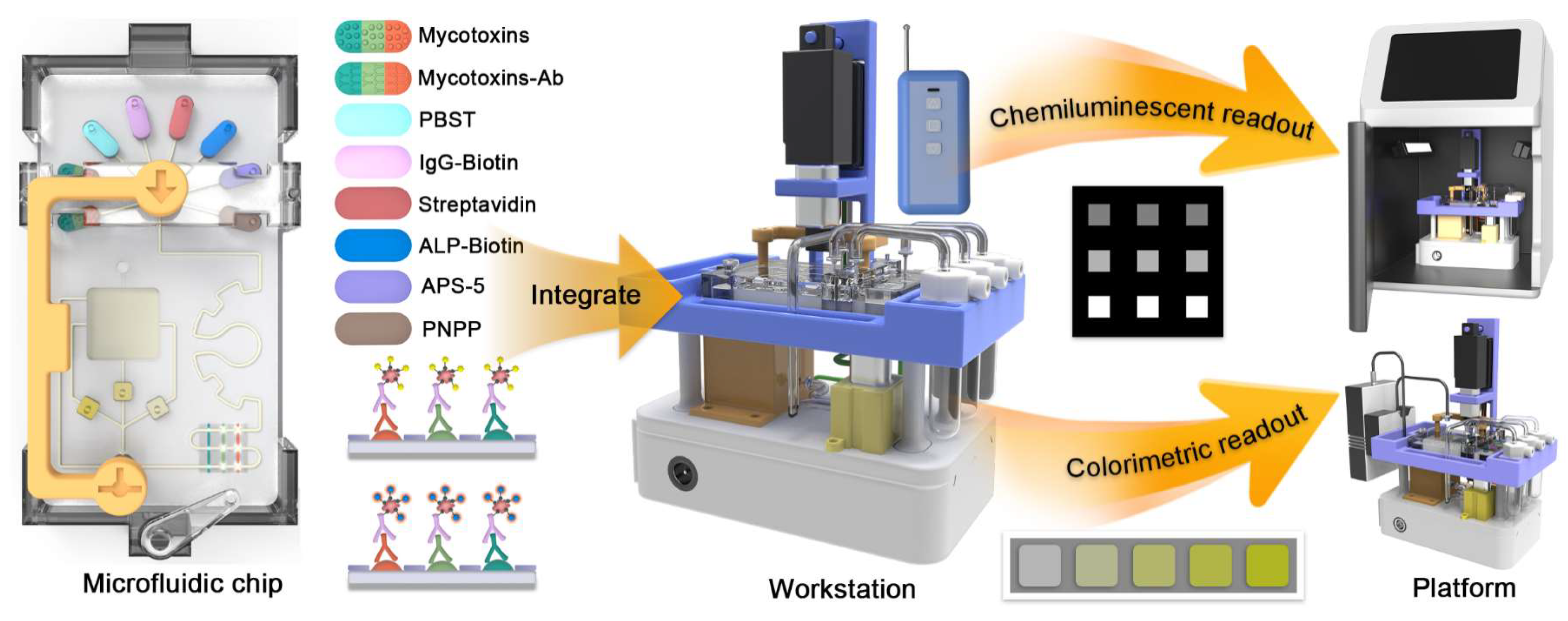
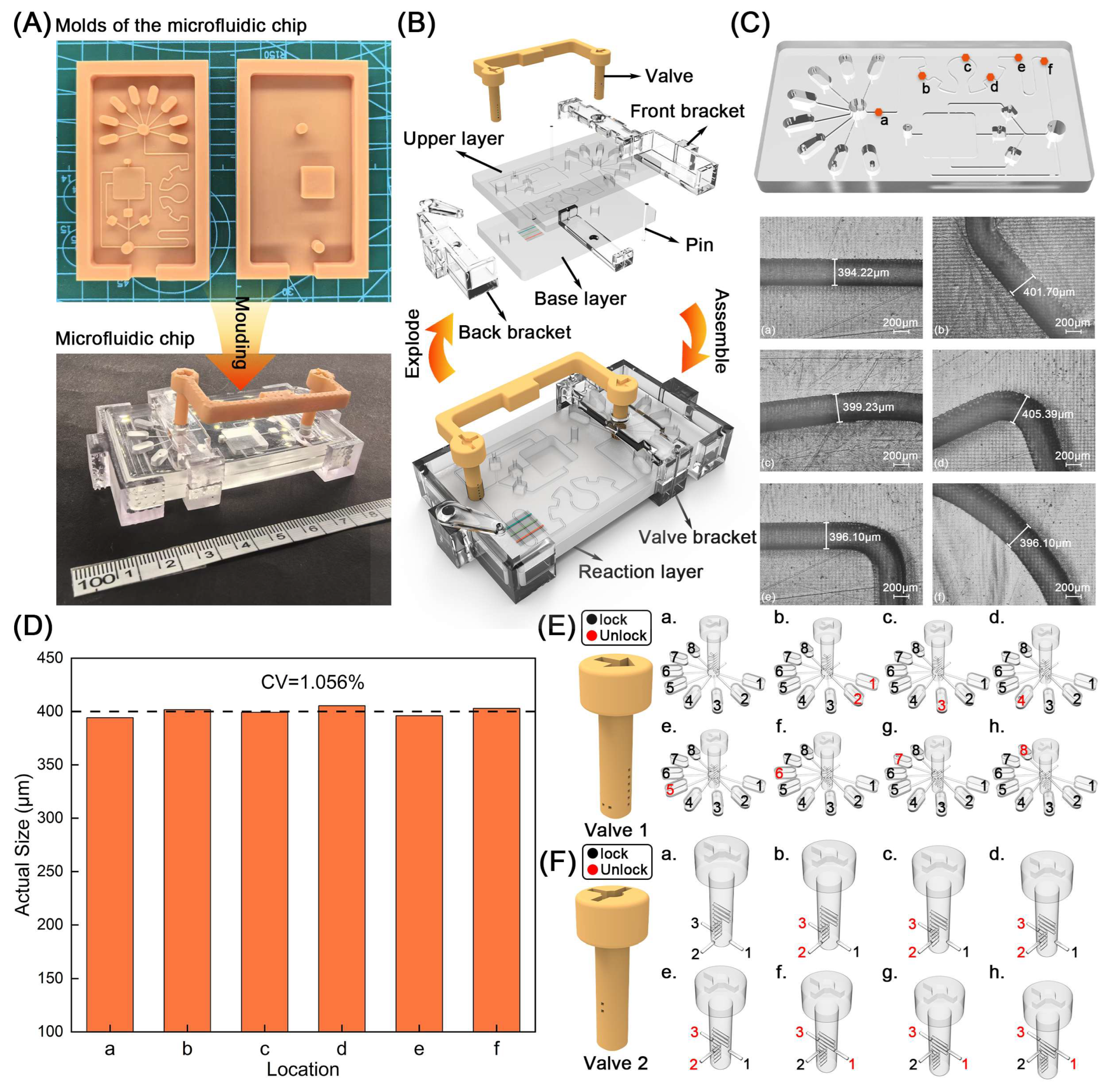
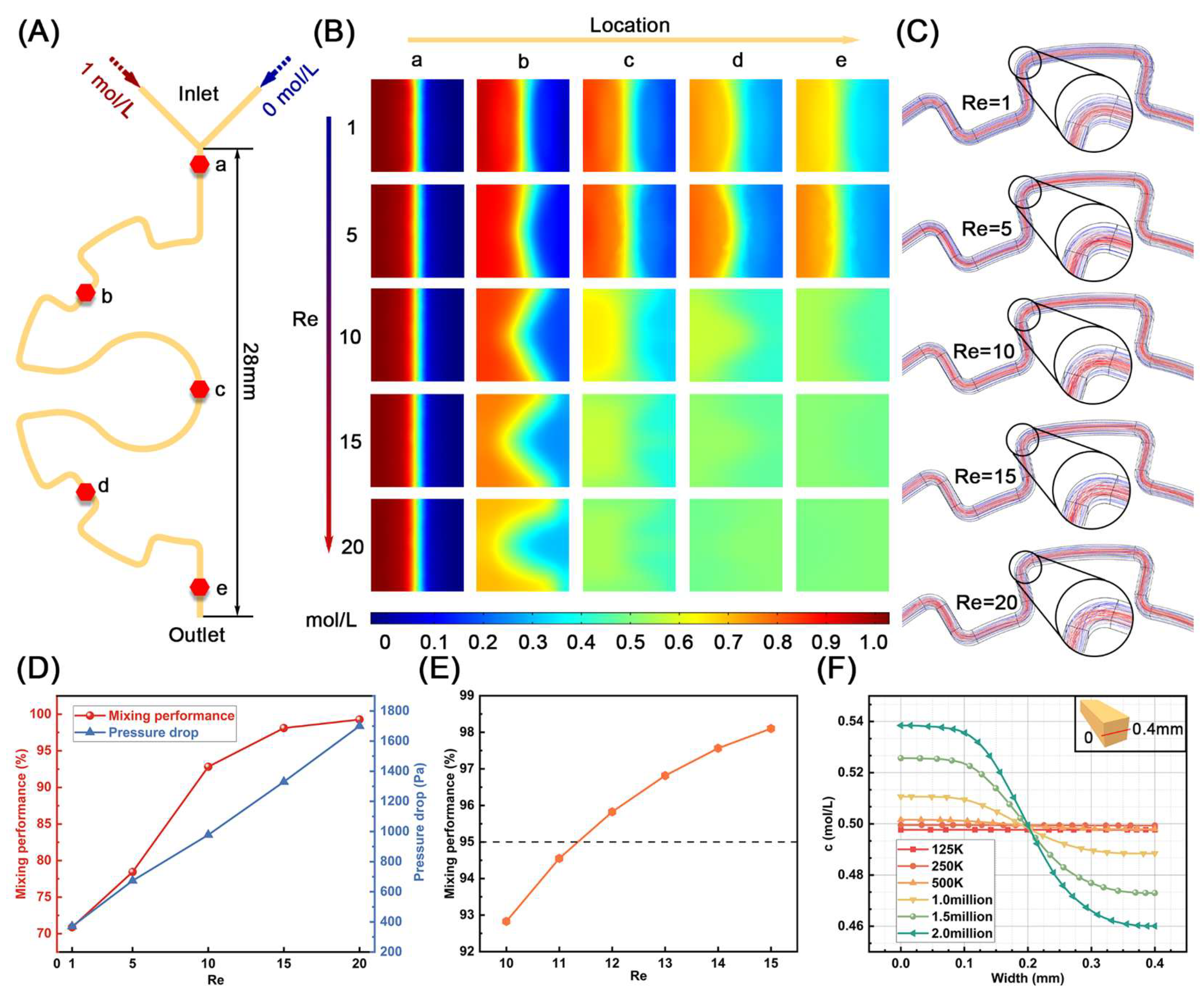
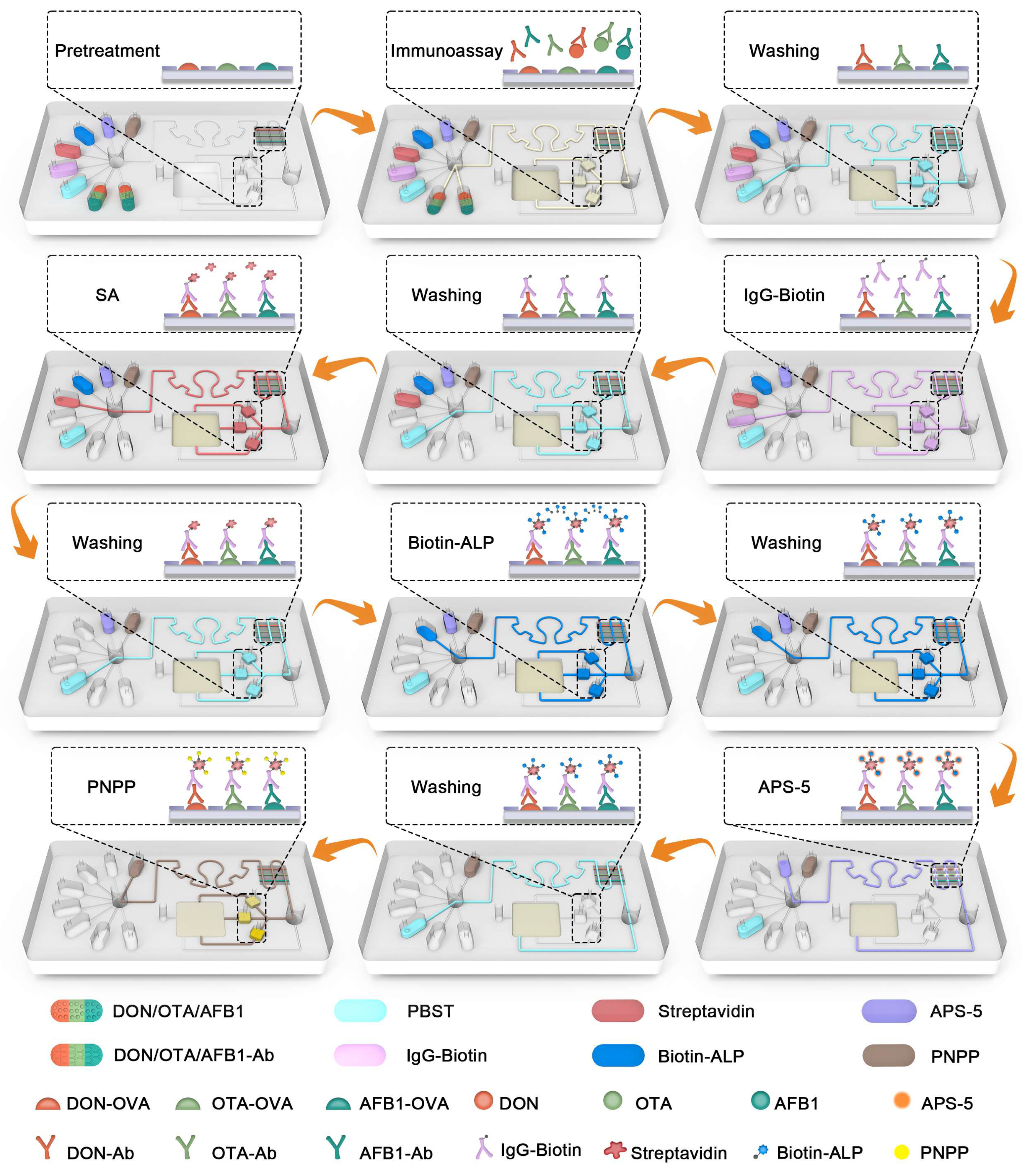
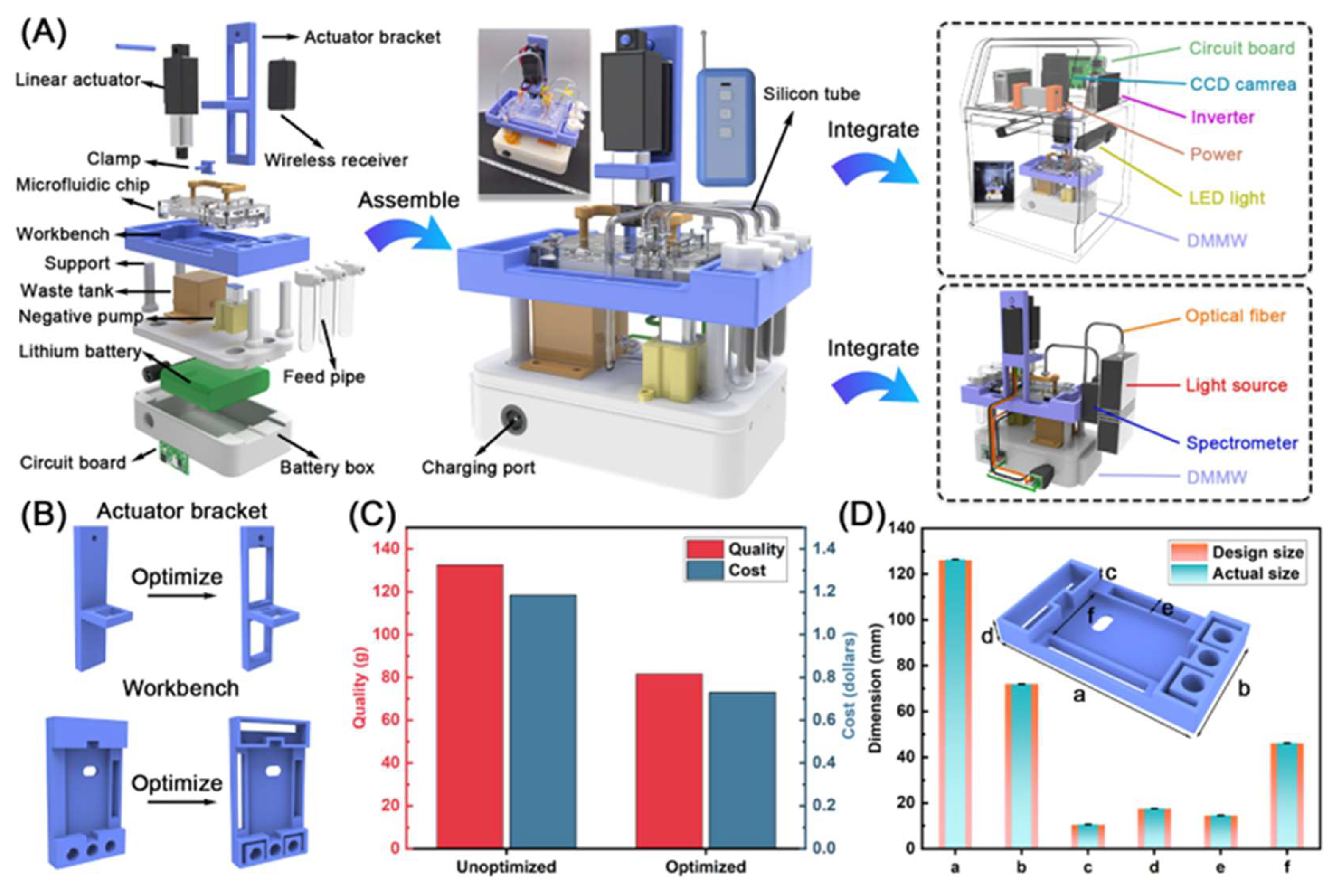
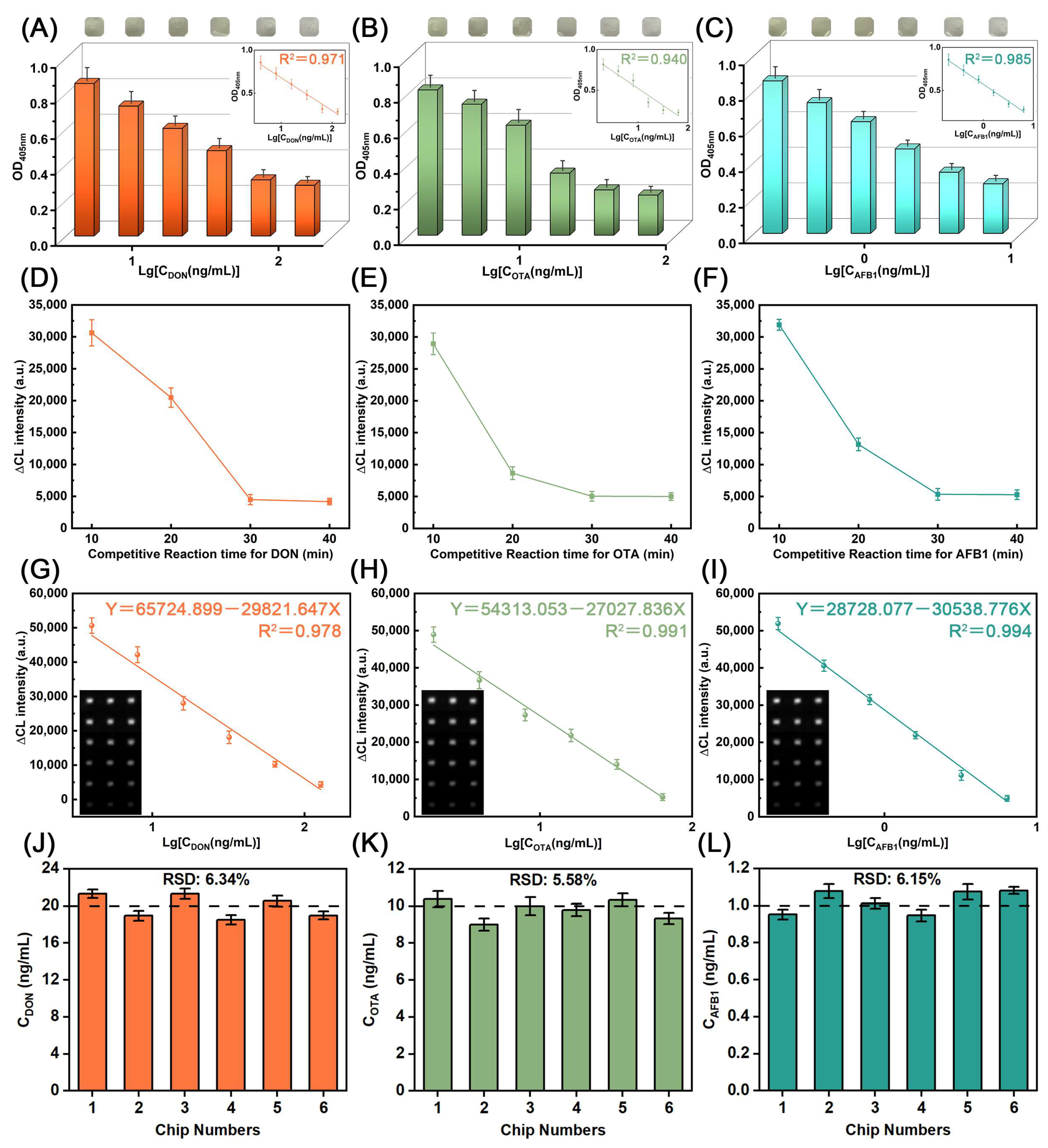
| DON | OTA | AFB1 | ||||||
|---|---|---|---|---|---|---|---|---|
| Spiked Value (ng/mL) | Recovery (%) | RSD (%) | Spiked Value (ng/mL) | Recovery (%) | RSD (%) | Spiked Value (ng/mL) | Recovery (%) | RSD (%) |
| 5 | 104.46 | 7.01 | 0.25 | 94.26 | 8.19 | 2.5 | 103.45 | 11.82 |
| 10 | 92.98 | 6.43 | 0.5 | 106.34 | 6.17 | 5 | 105.38 | 7.68 |
| 20 | 105.35 | 6.57 | 1 | 94.23 | 10.78 | 10 | 96.46 | 8.23 |
| 40 | 91.93 | 10.08 | 2 | 104.29 | 7.74 | 20 | 93.47 | 7.24 |
| 80 | 108.04 | 8.07 | 4 | 109.31 | 6.31 | 40 | 95.82 | 6.59 |
| Platform | LFIC | cFMEIS | UCNPs-mICA | SBCI | Ce-MOF@MIP | DMMW |
|---|---|---|---|---|---|---|
| Mycotoxins | DON AFB1 ZEA | AFB1 OTA DON ZEA | DON AFB1 ZEA | ZEA | AFB1 | DON OTA AFB1 |
| LOD | 73 ng/mL 45 ng/mL 43 ng/mL | 0.032 μg/kg 0.141. μg/kg 0.097 μg/kg 0.376 μg/kg | 0.25 ng/mL 0.05 ng/mL 0.1 ng/mL | 3 μg/kg | 0.25 ng/mL | 2.636 ng/mL 1.492 ng/mL 0.131 ng/mL |
| Real sample | Oat, cornmeal, millet | Wheat flour | Corn, wheat | Corn | Peanuts, chicken feed, corn | Beer |
| Signal form | Photothermal | Fluorescence | Fluorescence | SERS | Colorimetry | Chemiluminescence, colorimetry |
| Recovery (%) | 78.6–112.4 | 81.6–120 | 85.25–114.86 | 90.58–105.29 | 95.1–109.4 | 91.93–109.31 |
| RSD (%) | 2.80–7.20 | <6.00 | 0.53–1.71 | 6.43–11.82 | ||
| References | [41] | [42] | [43] | [44] | [45] | This work |
Disclaimer/Publisher’s Note: The statements, opinions and data contained in all publications are solely those of the individual author(s) and contributor(s) and not of MDPI and/or the editor(s). MDPI and/or the editor(s) disclaim responsibility for any injury to people or property resulting from any ideas, methods, instructions or products referred to in the content. |
© 2025 by the authors. Licensee MDPI, Basel, Switzerland. This article is an open access article distributed under the terms and conditions of the Creative Commons Attribution (CC BY) license (https://creativecommons.org/licenses/by/4.0/).
Share and Cite
Yin, B.; Zeng, S.; Liu, J.; Muhammad, R.; Jiang, Z.; Tan, G.; Yang, Q. Dual-Mode Microfluidic Workstation for Rapid Detection of Multiple Mycotoxins on Chip. Foods 2025, 14, 1928. https://doi.org/10.3390/foods14111928
Yin B, Zeng S, Liu J, Muhammad R, Jiang Z, Tan G, Yang Q. Dual-Mode Microfluidic Workstation for Rapid Detection of Multiple Mycotoxins on Chip. Foods. 2025; 14(11):1928. https://doi.org/10.3390/foods14111928
Chicago/Turabian StyleYin, Binfeng, Shiyu Zeng, Jun Liu, Rashid Muhammad, Zhuoao Jiang, Gang Tan, and Qi Yang. 2025. "Dual-Mode Microfluidic Workstation for Rapid Detection of Multiple Mycotoxins on Chip" Foods 14, no. 11: 1928. https://doi.org/10.3390/foods14111928
APA StyleYin, B., Zeng, S., Liu, J., Muhammad, R., Jiang, Z., Tan, G., & Yang, Q. (2025). Dual-Mode Microfluidic Workstation for Rapid Detection of Multiple Mycotoxins on Chip. Foods, 14(11), 1928. https://doi.org/10.3390/foods14111928







